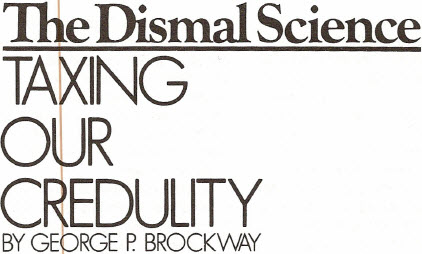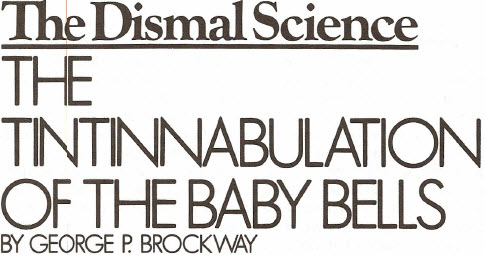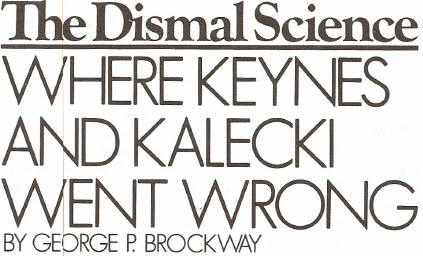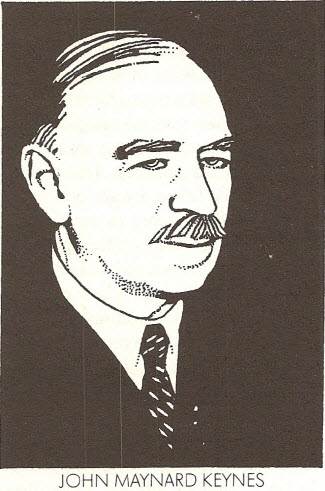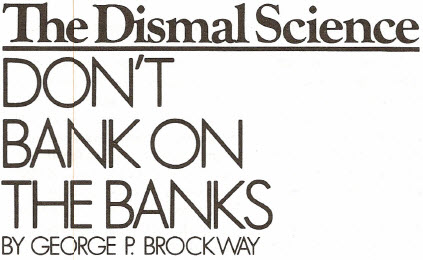By George P. Brockway, originally published December 2, 1991
EVERYONE seems to agree on two things. First, the economy is in a mess and something should be done about it. Second, neither the President nor congress did anything this year (beyond a belated extension of unemployment benefits), and nobody will want to do anything fundamental next year because of the election. If the second thing is correct, the first is moot: At least from now to 1993 we will have to test how we run on an automatic pilot that does not seem a whole lot more competent than the one in Airplane.
In the meantime, you and I can work off our frustrations by talking about them. We might as well start by talking about taxes, which can always generate heat on a wintry day. Several tax proposals are floating around Washington. All of them provide for reductions of one sort or another, most of them claim that they “target” the middle class, and some of them pretend to improve our productivity and beef up our international competitiveness.
The longest-running of the tax-cut schemes is Housing and Urban Development Secretary Jack F. Kemp‘s undismayed conviction that the way to balance the budget is to cut taxes à outrance. Kemp got us to go along with him on this scheme 10 years ago, when he was a New York Republican Congressman. He promised that savings and investment and tax collections would all increase, and we (present company excepted) believed him. None of his promises was fulfilled; instead we got an instant recession, followed by still burgeoning deficits. There is no reason to expect that what contributed to a recession yesterday will end a recession today.
The next longest-running notion is the President’s steadfast passion for a capital gains tax cut. The Education President told the children about it the other day when he visited a grade-school class. No one gave him an argument, but the best that can be said for the idea is that it might result in a modest one-time increase in tax collections as speculators rush to cash in old gains they’ve been sitting on.
Until 1987, when capital gains became taxed as ordinary income, executives with an eye to the main chance devoted endless time and ingenuity to schemes allowing them to take their compensation as capital gains. The use of stock options, a fairly routine dodge, could have gaudy results. One Donald A. Pels (whom you never heard of), CEO of LIN Broadcasting (which you never heard of), cashed his options in 1990 for $186,200,000 (which looks like a thousand times the speed of light). After paying taxes he had only $134,064,000 (plus a few millions in regular salary) left to show for 10 years’ work. If Bush had been able to get his tax cut through, Pels would have had $158,270,000 left, and his incentive wouldn’t have been so sapped.
Returning to a more mundane level, we find several Senators, Texas Democrats Lloyd Bentsen and Phil Gramm among them, eager to stir up lRAs again. You probably remember the commercials of a few years ago that had sports stars and movie actors earnestly urging us to join them in planning for a wealthy old age.
The beauty of it was that our self-serving endeavors would have the incidental effect of increasing the national saving rate and consequently the national investing rate. What happened, of course, is that those who participated merely switched their savings from one account to another. I can’t think why it would prove any different the second time around.
Finally, there are at least two proposals for reforming the income tax, both advanced by Democrats. A group led by Senator Albert Gore of Tennessee and Representative Thomas J. Downey of New York is pushing a plan they call (in pointed contrast to the President’s) the Working Family Tax Relief Act. This would reduce the taxes of 95 per cent of all families with children. Cuts would range from roughly $875 at the bottom of the income scale to $185 at the top; singles and families without children would continue to pay the present rates. The reductions would be paid for by increasing the taxes of the richest 1 per cent of taxpayers (whose average income is $676,000) by an average of $21,600, and of the next 4 per cent (whose average income is$132,000) by an average of $530. These increases are about 3.2 per cent and 0.4 per cent of the respective incomes. You will note that the Working Family Tax Relief Act is intended to be “revenue neutral” and so doesn’t upset last year’s budget agreement.
The simplest proposal has been made by Representative Dan Rostenkowski (D.-Ill.), Chairman of the Joint Committee on Taxation, who would allow a tax credit equal to one- fifth of Social Security and Medicare taxes. He would pay for it by boosting the tax on the richest 1 per cent; so he would be revenue neutral, too.
The effects of his plan on individuals look like this: The median family had an income in 1989 (the latest figure I can lay my hands on) of $35,975. Assuming that the entire income is from wages, the family pays $2,752.09 in Social Security taxes (which is an outrage, as Senator Moynihan says). One-fifth of that tax is $550.42, or $10.58 a week-not enough to make a difference in financing a new car or a new home or even a new video camcorder, but certainly welcome as a help in covering expected increases in bus and subway fares.
Chairman Rostenkowski’s average cut is about the, same as Senator Gore’s for a $75,OOO income. Since the Chairman’s plan is tied to Social Security taxes paid, the benefit for the lowest quintile of taxpayers is dramatically lower – $161, as opposed to the Senator’s $875. Also, of course, the cap on Social Security taxes puts a cap on Rostenkowski’s benefits – about $8S0, which would apparently be available to everyone right up to whoever succeeds Donald Pels as leader in the income sweepstakes.
Speaker Tom Foley of the state of Washington says he expects the House to pass Rostenkowski’s plan. Congressman Newt Gingrich of Georgia, the Republican whip, sneers that the plan would merely redistribute the wealth but would not make more money available for investment. For my part, I don’t think redistributing the wealth is such a bad idea. After all, those at the top of the income pyramid had wealth redistributed to them by the Kemp-Roth tax law 10years ago. As Jeff Faux of the Economic Policy Institute puts it, the bill should be sent to those who went to the party and are thirsting for another one.
If the purpose is to jump-start the economy, the trouble with all these plans is in the timing. Even if we could get Congress and the President to agree on one of them, could run it successfully past the House Ways and Means Committee and the Senate Finance Committee, and could manage veto-proof majorities in both houses (in case the President noticed at the last minute that the cost of an abortion would still be a deductible medical expense} – even then little good would come of it in our winter of discontent.
With luck we might put our 1040s in order by April 15 and begin getting our hands on the increased disposable income a week later, with spring already a month old. The economy would no doubt be startled, but the time for jump-starting would be past. This is not to suggest that the tax schedule should not be changed, and right quickly. As I’ve said before (see “The Evils of Economic Man,” NL, July 9-23, 1990), our economy and the society it supports are in for a long decline unless we correct our present course toward increased polarization.
So the correct answer to the multiple choice question asking which scheme will end the recession seems to be “None of the above.” None of the proposals on the table is likely to do much to get the economy out of the doldrums. Furthermore, they are not self-sufficient. Each silently assumes that a further step will be taken, yet that depends on whether their beneficiaries will be of a mind to take it. If they are not psychologically ready to spend their benefits with enthusiasm, the effects on the economy will be tentative and minimal.
WHAT IS needed is something positive to get money circulating – to get people working, to get consumers consuming, to get producers producing. I can think of two ways to achieve these results.
The first is the way we’ve done it for the past decade: Damn the deficit and go ahead with a military buildup. The effectiveness of defense spending has been demonstrated repeatedly over the centuries, from Periclean Athens to Reaganite America. Not the least of its virtues is its dramatic size. It is plainly visible. Its impact on localities and industries and job classifications can be calculated and counted upon, and so can the multiplier effects that spread throughout the economy. Plans can be made to get a piece of the action. Things start stirring very quickly.
Happily, there is another way. We are not doomed to waste our wealth and energy on devices we hope will never be used. Again we can learn from Periclean Athens, which is remembered now less for the power of the Delian League than for the wonders of the Acropolis, the most glorious public works project the world has yet seen.
American public works projects have hitherto been hampered by the lack of ready plans; consequently, they have been viewed as too slow-starting to be useful in ending a recession. But it happens that this is not true today of the states and municipalities.
Partly because of the niggardliness of the Reagan-Bush “New Federalism,” and partly because of the current recession, state and local governments have been in trouble for a couple of years and are in grave trouble now. Caught between constitutional requirements that they balance their budgets and the blind frenzy of taxpayers’ revolts, they have had to abandon capital improvements, emasculate services and fire thousands upon thousands of employees.
These draconian measures could be reversed in a moment. New York City alone has a list of several hundred bridges it needs to repair. Work on many of these could start tomorrow if money were available. In almost every city and suburb, library hours have been reduced and branches closed; what only a year ago was a marvelously helpful and rapid system of inter-library loans currently operates only sluggishly. The people who used to make that system function could be rehired overnight. The second cop who used to man patrol cars is also ready to return to duty in a flash. A year’s volume of this magazine could be filled with examples from every corner of the land.
If Federal grants to state and local governments were restored merely to the same proportion of Federal expenditures as in 1980, a sum of $63.1 billion would be available to fund such projects and break the back of the recession-peacefully. Could we do it? Well, we spent a lot more than that trying to drive Saddam Hussein from office. We could do it, all right, if we had the sense and the will.
The New Leader
